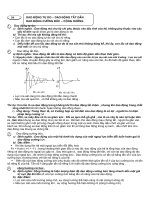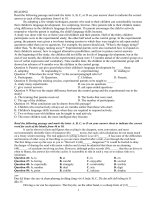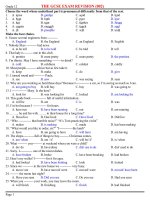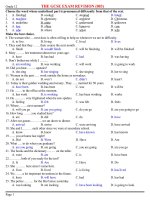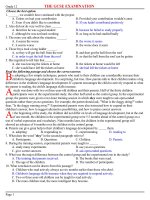GCSE 030
Bạn đang xem bản rút gọn của tài liệu. Xem và tải ngay bản đầy đủ của tài liệu tại đây (72.33 KB, 5 trang )
SƠ GD&ĐT VINH PHUC
TRƯƠNG THPT LIÊN SƠN
(Đề thi gồm: 05 trang)
ĐỀ KTCL ƠN THI THPT QUỐC GIA NĂM 20182019
Mơn: TIẾNG ANH – ĐỀ SỐ 030
Thời gian làm bài: 60 phút, không kể thời gian phát
đề
Ho va tên thi sinh:……………………………………………………………………. SBD:…………………………
Mark the letter A, B, C, or D on your answer sheet to indicate the underlined part that needs
correction in each of the following questions.
Question 01: There are many reasons why a particular species may become endangering.
A. endangering
B. may
C. a
D. reasons why
Question 02: There are some people in the government try to improve the lives of poor people.
A. to improve
B. There are
C. lives
D. try
Question 03: If I had studied carefully, I wouldn’t make so many mistakes.
A. carefully
B. had
C. make
D. so many
Read the following passage and mark the letter A, B, C, or D on your answer sheet to indicate
the correct answer to each of the questions.
Insects' lives are very short and they have many enemies, but they must survive long enough
to breed and perpetuate their kind. The less insect-like they look, the better their chance of survival.
To look "inedible" by imitating plants is a way frequently used by insects to survive. Mammals rarely
imitate plants, but many fish and invertebrates do.
The stick caterpillar is well named. It is hardly distinguishable from a brown or green twig.
This caterpillar is quite common and can be found almost anywhere in North America. It is also
called "measuring worm" or "inchworm." It walks by arching its body, then stretching out and
grasping the branch with its front feet then looping its body again to bring the hind feet forward.
When danger threatens, the stick caterpillar stretches its body away from the branch at an angle
and remains rigid and still, like a twig, until the danger has passed.
Walking sticks, or stick insects, do not have to assume a rigid, twig-like pose to find
protection; they look like inedible twigs in any position. There are many kinds of walking sticks,
ranging in size from the few inches of the North American variety to some tropical species that may
be over a foot long. When at rest their front legs are stretched out, heightening their camouflage.
Some of the tropical species are adorned with spines or ridges, imitating the thorny bushes or trees
in which they live.
Leaves also seem to be a favorite object for insects to imitate. Many butterflies can suddenly
disappear from view by folding their wings and sitting quietly among the plants that they resemble.
Question 04: Which of the following is the antonym of the word “inedible” in paragraph 3?
A. eatable
B. colorful
C. moving
D. beautiful
Question 05: According to the passage, how does the stick caterpillar make itself look like a twig?
A. By laying its body flat against a branch
B. By changing the color of its skin
C. By holding its body stiff and motionless
D. By looping itself around a stick
Question 06: Which of the following does the word “enemies” in line 1 refer to?
A. extreme weather conditions
B. creatures that eat insects
C. plants looking like insects
D. insects looking like plants
Question 07: Which of the following best paraphrases the sentence in italics? The stick caterpillar is
well named.
A. The caterpillar has a good name.
B. The caterpillar is stuck to a popular name.
C. The caterpillar is named just like the way it looks.
D. The caterpillar is named after a well-known name.
Question 08: Which of the following are NOT mentioned in the passage as objects that are imitated
as a means of protection?
A. leaves
B. flowers
C. thorns
D. sticks
Question 09: Which of the following is true of stick insects?
A. They make themselves look like other insects.
B. They change color to make themselves invisible.
C. They are camouflaged only when walking.
D. They resemble their surroundings all the time.
Question 10: What is the main idea of the passage?
A. Insects that are threatened with extinction
B. The feeding habits of insects
C. How some insects imitate plants to survive? D. Caterpillars that live in trees
Mark the letter A, B, C, or D on your answer sheet to indicate the sentence that is closest in
meaning to each of the following questions.
Question 11: If it hadn’t been for his carelessness, we would have finished the work.
A. Because he wasn’t careless, we didn’t finished the work.
B. He was careless because he hadn’t finished the work.
C. If her were careful, we would finish the work.
D. If he had been more careful, we would have completed the work.
Question 12: People say that Cameron was the best director of his time.
A. Cameron is said to have been the best director of his time.
B. Cameron is said to be the best director of his time.
C. It was said that Cameron was the best director of his time.
D. Cameron was said to have been the best director of his time.
Question 13: I was offered to work for IBM, but I rejected.
A. I rejected to offer to work for IBM.
B. I was refused by IBM at work.
C. I turned down the offer to work for IBM.
D. IBM refused my offer to work.
Mark the letter A, B, C, or D on your answer sheet to indicate the word(s) CLOSEST in meaning
to the underlined word(s) in each of the following questions.
Question 14: He crumpled up the letter and flung it into the fire.
A. burned
B. lanced
C. put
D. threw
Question 15: Is the boss going soft in the head?
A. crazy
B. annoyed
C. exhausted
D. vexed
Mark the letter A, B, C, or D on your answer sheet to indicate the sentence that best combines
each pair of sentences in the following questions.
Question 16: The security guards caught a thief. He was attempting to steal a painting.
A. It was not until the thief attempted to steal a painting that the security guards caught him.
B. Whenever the thief attempted to steal a painting, the security guards caught him.
C. The security guards caught a thief attempting to steal a painting.
D. The security guards caught a thief because he was attempting to steal a painting.
Question 17: I won't lend you anything more. Pay me back what you borrowed last week.
A. I will not lend you anything more if you pay me back what you borrowed last week.
B. Pay me back what you borrowed last week, so I won't lend you anything more.
C. If you pay me back what you borrowed last week, I'll will lend you anything.
D. I won't lend you anything more unless you pay me back what you borrowed last week.
Mark the letter A, B, C, or D on your answer sheet to indicate the sentence that best completes
each of the following exchanges.
Question 18: Lan: “How long does it take to get to the town centre from here?”
Mai: “____________________________”
A. It costs fifteen cents by bus.
B. I’m driving to the town center this evening.
C. No more than fifteen minutes, if the traffic is light.
D. There’s a bus every thirty minutes.
Question 19: Tom: “Thanks for your help!”
Jerry: “_______________”
A. All it is for you.
B. It’s my pleasure.
C. With all my heart. D. Never remind me.
Read the following passage and mark the letter A, B, C, or D on your answer sheet to indicate
the correct answer to each of the questions from 20 to 26.
SECRET TO SUCCESS
Most of us have been on the receiving end of an inspirational speech. Usually it is delivered
by a former Olympian at a company conference and is all about the big M: motivation. It is
sometimes eloquently delivered and often fun to listen to but most people leave the room
wondering how thirty minutes of biographical information about a rowing champion is going to
help them back in the office. Nobody would dispute that motivation is a key driver of performance
but this knowledge does not help many of us understand where it comes from.
Listening to a sportsperson speaking about their own personal journey may be uplifting but
how is it going to leave a lasting and usable legacy in terms of how you approach your job? It is
almost insulting to think it could. It is not anecdotes we need, so much as a science of performance,
underlying principles that help unlock the question of why some people work hard and excel while
others don't; why some are committed to what they are doing while others exist in a state of semidetachment, it is a question with ramifications not just for business but for education. And,
fortunately, the answers are beginning to emerge. To see how, we need to take a step back and ask a
deeper question: where does excellence come from?
For a long time, it was thought that the answer hinged, in large part, upon talent. Hard work
may be important but if you don't have the ability you are never going to become top class. It is the
notion that high-level performers have- excellence encoded in their DNA. It turns out that this point
of view is mistaken. Dozens of studies have found that high flyers across all disciplines learn no
faster than those who reach lower levels of attainment - hour after hour, they improve at almost
identical rates. The difference is simply that high achievers practise for more hours. Further
research has shown that when students seem to possess a particular gift, it is often because they
have been given extra tuition at home. The question of talent versus practice/experience would not
matter much if it was merely-theoretical. But it is much more than that. It influences the way we
think and feel, and the way we engage with our world. And it determines, our motivation. To see
how, consider an employee who believes success is all about talent - this is known as the 'fixed
mindset'. Why would they bother to work hard? If they have the right genes, won't they J’ust cruise
to the top? And if they lack talent, well, why bother at all? And who can blame someone for having
this kind of attitude, given the underlying premise? If, on the other hand, they really believe that
practice trumps talent - the 'growth mindset' - they will persevere. They will see failure as an
opportunity tó adapt find grow. And if they are right, they will eventually excel. What we decide
about the nature of talent, then, could scarcely be more important.
So, how to create a growth mindset within an organization? Interventions which have
presented participants with the powerful evidence of how excellence derived from perseverance which explains the possibility of personal transformation - have had a dramatic impact on
motivation and performance. When this is allied with
clearly identifiable pathways from shop floor to top floor, so that employees can see the route ahead,
these results are strengthened further.
Businesses that focus on recruiting external 'talent' with 'the right stuff on the .other hand,
and who neglect the cultivation of existing personnel, foster the fixed mindset. A rank and-yank
appraisal system is also damaging because it suggests that the abilities of these ranked the lowest
cannot be developed. In short, an ethos constructed upon the potential for personal transformation
is the underlying psychological principle driving high performance. It is an insight that is not merely
deeply relevant to business but to any organization interested in unlocking human potential.
Question 20: According to the writer, employers need to________
A. encourage ambition in their employees.
B. record the development of each employee.
C. reward good performance of their employees.
D. ensure employees know their place in a company.
Question 21: The writer believes we should learn more about________
A. the ways people's commitment to tasks can be developed.
B. the factors behind motivation.
C. the similarities between practices in business and education.
D. the importance of workers' different principles.
Question 22: The writer is concerned that motivational speeches do not________
A. respect the listeners.
B. interest the audience.
C. carry conviction.
D. give useful advice.
Question 23: Research suggests that successful people________
A. benefit from personal training.
B. can learn very quickly.
C. do not need to work hard.
D. have an innate talent,
Question 24: In paragraph 4, the writer poses several direct questions in order to________
A. consider different situations.
B. emphasise his point.
C. make readers consider their own experiences. D. invite comment.
Question 25: The word ‘ramifications’ is closest in meaning to________
A. imminent effects B. oncoming interests
C. probable incidents D. possible results
Question 26: The writer uses the phrase a rank-and-yank appraisal system to refer to________
A. promotion that is too rapid.
B. insufficient investment in personal development.
C. an acceptance of poor performers at high levels.
D. changing the recruiting strategy of a company.
Mark the letter A, B, C, or D on your answer sheet to indicate the word whose underlined part
differs from the other three in pronunciation in each of the following questions.
Question 27:
A. computer
B. citizen
C. economy
D. technique
Question 28:
A. consist
B. consume
C. concept
D. conclude
Mark the letter A, B, C, or D on your answer sheet to indicate the word(s) OPPOSITE in meaning
to the underlined word(s) in each of the following questions.
Question 29: The local council refused him planning permission to build an extra bedroom.
A. accept
B. deny
C. agree
D. consent
Question 30: I was trying to keep the party a secret, but Melinda went and let the cat out of the
bag.
A. conceal
B. disclose
C. renounce
D. refrain
Mark the letter A, B, C, or D on your answer sheet to indicate the word that differs from the
other three in the position of primary stress in each of the following questions.
Question 31: A. compromise
B. supervise
C. televise
D. determine
Question 32: A. enclose
B. disclose
C. purpose
D. suppose
Mark the letter A, B, C, or D on your answer sheet to indicate the correct answer to each of the
following questions.
Question 33: The_________ I like most in people are friendliness and generosity.
A. conditions
B. qualities
C. aspects
D. qualifications
Question 34: I wasn’t really ill yesterday - I was just_________ to be ill because I didn't want to go out.
A. pretending
B. copying
C. imitating
D. acting
Question 35: If I were rich, I_________ those in need.
A. would have helped B. will help
C. would help
D. can help
Question 36: We found a nice quiet_________ on the beach to sunbathe.
A. line
B. point
C. spot
D. stage
Question 37: Mrs. Willis is known for her innovative teaching_________
A. habits
B. plans
C. methods
D. policies
Question 38: York is about_________ from here.
A. a two hours’ drive B. a drive for two hours
C. two hours drive D. a two-hour drive
Question 39: I’d rather_________ home tonight.
A. stayed
B. stay
C. to stay
D. staying
Question 40: I_________ myself to Professor Lan Phuong at the party.
A. introduced
B. greeted
C. presented
D. identified
Question 41: We don 't know when they_________ back.
A. are
B. will be
C. have been
D. are being
Question 42: There is_________ nothing we can do to change their decision, unfortunately.
A. totally
B. extremely
C. absolutely
D. considerably
Question 43: Do you object_________ now?
A. to my leaving
B. to leave
C. that I leave
D. leave
Question 44: _________ give me a hand with the bags?
A. Should you
B. Must you
C. May you
D. Will you
Question 45: Using the new software, _________ parents will be able to monitor their children’s use of
_________ Internet.
A. the/the
B. 0/the
C. 0/0
D. the/0
Read the following passage and mark the letter A, B, C, or D on your answer sheet to indicate
the correct word or phrase that best fits each of the numbered blanks from 46 to 50.
Left-handers are the odd ones out. Sure, lefties (46)_________ up about 10 percent of the
population - but, frankly, it seems like society has forgotten about them. Just consider all of the
right-handed gadgets, awkwardly designed desks, and cooking tools that fit comfortably only in
your right hand. What (47)_________ someone to become a lefthand? Scientists aren’t exactly sure, but
research points to a complex (48)_________ between genes and environment While no exact set of
“leftie genes” have been discovered, people who dominantly use their left hands do have more lefthanded family members. And researchers have found different brain wirings in righties vs. lefties.
But no matter (49)_________ it is that drives someone to use their antipodal paw, science has also
uncovered a particular set of personality traits that left-handed people tend to have. So for all of you
lefties, leftie-loving righties, and ambidextrous folks out there - it’s time to brush up on your lefthanded knowledge and help (50)_________ an end to leftie discrimination once and for all.
Question 46:
A. consist
B. account
C. hold
D. make
Question 47:
A. causes
B. makes
C. gets
D. does
Question 48:
A. collaborate
B. collaboration
C. collaborating D. collaborated
Question 49:
A. which
B. who
C. what
D. that
Question 50:
A. put
B. bring
C. make
D. take
__________THE END__________
